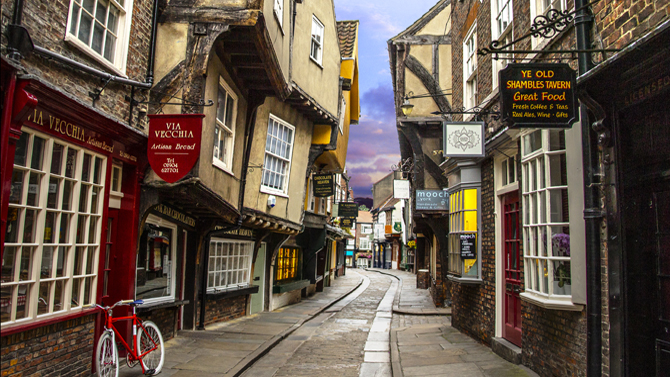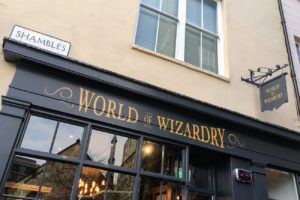It was mentioned in Domesday Book in 1086 but the present York street we call the Shambles is clearly later. The houses were built of wide timber frames although the framing is now covered by plaster or hidden by brick frontages. Nobody comes to York without succumbing to its charms. It used to be full of butchers’ shops with the meat hanging from hooks or displayed on broad shelves known as fleshammels. Raw waste would be thrown into a drainage channel running down the middle so there would have been a horrible stench and dirt and flies everywhere. The most famous Shambles resident was butcher’s wife Margaret Clitherow who died a martyr in 1586 for refusing to recognise Elizabeth 1’s Anglican church settlement. She was made a saint in 1970 and has her shrine in one of the timbered houses.
Nowadays visitors are flocking to the Shambles in larger numbers than ever to walk its cobbles and get some selfies because it looks so like Diagon Alley. J. K. Rowling may well have been inspired by it and location hunters for later film sets have admitted as much, but the Shambles we enjoy visiting today is certainly not the Diagon Alley portrayed in the Harry Potter films. That’s at Leadenhall Market in London and Warner Bros Studios! The bridge at York Railway Station does appear in The Philosopher’s Stone when Harry and Hagrid walk across it on their way to a famous Platform. Goathland Railway Station on the North York Moors was used as Hogsmeade in the same film and Malham Cove in the Yorkshire Dales was where Harry and Hermione hid from Voldemort in The Deathly Hallows. However, although Yorkshire has a flourishing film industry, Harry Potter seems to have spent more time filming elsewhere! Nevertheless, the Shambles has really embraced him and he has three shops -The Shop That Can’t Be Named, The Boy Wizard and The World of Wizardry – selling a range of gifts from wands and goblets to stuffed owls!
Contributed by Louise Fawn – a York and Yorkshire Blue Badge Guide.
Yorkshiresbestguides.co.uk
Britainsbestguides.org.uk



